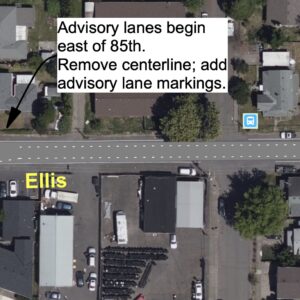
The Pedestrian and Bicycle Advisory Committee (PBAC, see list of members below) for the Columbia River Crossing project has released a 13-page memo that outlines their recommendations related to bridge design options and details their requirements for a “world-class” bicycle and pedestrian facility.
Not surprisingly, the PBAC is recommending the replacement bridge option and writes that, compared to the supplemental bridge design option,
“the replacement bridge option would provide the most direct and safe routes for pedestrians and bicyclists between Vancouver, Hayden Island, and North Portland.”
While the Draft Environmental Impact Statement (DEIS) only includes language for a single pathway “at least 16 feet” wide, this memo seeks to make it clear that once a Locally Preferred Alternative (LPA) is chosen, there will still be room to suggest more a more robust facility.

(Photo © J. Maus)
Some members of the BAC — including the BTA’s representative Emily Gardner — have advocated for 20-foot wide paths on each side of a new bridge.
Just how much the design can change after the LPA is chosen depends on who you ask.
Skeptics of the project claim that the language approved as part of the DEIS process limits how much the actual facility can change going forward. On the other hand, CRC staff (and other supporters including Rex Burkholder) have told me that the DEIS (and the LPA decision based on it) is nothing more than a jumping off point and that the vast majority of the design decisions are left to come.
In addition to recommending the replacement bridge option, the PBAC writes that the bridge “must include a world-class pedestrian and bicycle facility.”
Their definition of “world-class” is a design that serves the needs of bikes and peds for the “next 50 plus years” and includes separation of various users groups based on speed of travel, good visibility and sight lines, minimal changes in elevation, “ample width” for all users to pass each other, and more.
In a list of detailed “recommendations”, the PBAC says the replacement bridge must include, “a 12-foot wide regional trail adjacent to, and to the west of, a pair of six-foot wide bicycle lanes (see rendering above).” They also call for a series of “belvederes” or viewpoints along the path where people can pull over and rest when necessary.
The memo will be sent to the CRC Task Force prior to their meeting on Tuesday (6/24), where they will make their own recommendation of which alternative should move forward.
For more information, read my past coverage of the Columbia River Crossing.
Download the complete memo here (PDF, 2.5MB)
Below are the members of the CRC’s bicycle and pedestrian advisory committee:
-
April Bertelsen, City of Portland
Todd Boulanger, City of Vancouver
Kyle Brown, Steps to a Healthier Clark County
Coalition for a Livable Future – inactive
Basil Christopher, Oregon Department of Transportation
Seanette Corkill, Arnada Neighborhood Association
Bob Cromwell, National Park Service
Debbie Elven-Snyder, C-TRAN
Emily Gardner, Bicycle Transportation Alliance
Roger Geller, City of Portland
Lisa Goorjian, City of Vancouver
Joe Greulich, Clark County Bicycle Advisory Committee
Rod Merrick, Portland Pedestrian Advisory Committee
Paula Reeves, Washington State Department of Transportation
Shayna Rehberg, Portland Bicycle Advisory Committee
Karl Rohde, Bicycle Transportation Alliance
Walter Valenta, Bridgeton Neighborhood Association






Thanks for reading.
BikePortland has served this community with independent community journalism since 2005. We rely on subscriptions from readers like you to survive. Your financial support is vital in keeping this valuable resource alive and well.
Please subscribe today to strengthen and expand our work.
Why do we fight over crumbs? Whatever facilities that are provided to cyclists and pedestrians matters less than whether and how many additional auto lanes are being built. If there is any more car capacity, then we have lost.
There is a CRC poll up at the Portland Biz Journal.
It is a flawed poll, as it only gives two options – much like the CRC recommendations of build or no build, without any options in the middle.
But the \”builds\” are winning.
Not if we can help it. Freep that poll, people!
clear your cookies, vote again!
It\’s worth to fight over the crumbs because having ample dedicated bike and pedestrian facilities are so important right now. Even in relatively \”green\” cities like ours, non-motorized access over bridges are frequently abysmal. Narrow sidewalks, congestion, and difficult access to the bridges from the ground.
But for me, the prospect of getting a real high class pathway, safe, wide, and useful access between Marine Drive, Delta Park, and Vancouver\’s Esther Short and Discovery Trail – that would be huge. To show that kind of dedication on an expensive bridge is valuable and worthwhile to the community will impact not only our town, but the ways that other cities consider how their own bridges and roadways be replaced.
To me, that\’s more important than the number of car lanes. 3. 6. 12. Just do it. Build a bridge with mass transit, pedestrians, bikes, everyone gets access. Show that it works, and people will change how they think bridges should be designed in the future.
Anonymous – thanks for the comments – too bad you have to stay nameless for you own [bike] safety.
all of the proposed bike ped options being considered above will result in another underdesigned / overcapacity facility, just like the eastside esplanade – too narrow from the day it opened.
Are you kidding me? World-class? 12\’ for bidirectional travel is not world-class. I mean, if they think that that\’s going to accommodate bicycles for 50 years with enough room for people of all skills and comfort levels and include passing – not happening. The cycling facilities need to be significantly wider.
Why don\’t we make the car lanes 6\’ wide too? Six 6\’-wide lanes would actually be narrower in total than even the older of two current spans. I know the FHWA would never allow it, partly because I\’m only kidding, but at least it causes you to think.
Russell – what is world class to you?
I think size is not so much an issue, as is what it is being attached to.
12 feet for bikes and pedestrians attached to almost 200 feet for cars?
And how can you enjoy the river when it will be loud, dirty, and you will only ever be able to look at one side of the bridge…
Will the bridge be boring and depressing like the Glen Jackson (205) bridge?
World Class is not so much just about size, as it is about the \”content\”. What are we building as a whole? What does it mean to our society?
There are some 12 foot wide bridges that are \”world class\” and there are some wider bridges that are plain old boring.
Look at the Mellenium bridge in London, or the Calatrava bridge in Petah Tikvah. The Charles bridge in Prague.
Or more modestly you could look at the Berkeley East Shore Overcrossing – which is both stylish AND 15 feet wide.
But to be \”world class\” you look at the sum of the parts. For example, you can have a barely 6 or 10 foot wide bridge, like the Poughkeepsie Railroad Bridge walkway – which would be \”world class\” because of it\’s significance and length…
But if we are attaching this to just another crappy freeway bridge, then it needs to be at LEAST one car lane width (14 feet) and to be \”world class\” it needs to be at LEAST two car lane widths (28 feet) – with \”pull outs\” for people to stop and look at the scenery and take pictures and rest.
I don\’t know what the fuss is – a bike/ped deck costs less, weighs less, and requires much less maintenance than car decks. So we should be able to add a couple lanes of bike/ped deck on to an already being built bridge – pretty easily and inexpensively.
Another Glenn Jackson or Marquam is not \”world class\”.
NO CRC!
Traffic jam isn\’t a bad thing, driving is.
We have way more important transportation priorities than just burn all this money on another car facility.
The designers should look to the Sundial Bridge in Redding CA for inspiration
http://www.solsticeatthesundial.com/links/about.html
John R – your theme is correct about content…
…but you should get up to speed on the likely design of the bridges.
None of the current designs are recommending a ped bike sandwich as the I-205 has – we the users of these facilities have learned that hard lesson and voiced it unison to the CRC highway engineers.
The likely LPA /recommended layout would be a replacement bridge and with a wider shared use path attached to the west side of the separate LRT bridge away from the cars/ trucks and off to one side or under (less noise and fumes) and a direct route vs weaving across and under I-5. See the drawing at the lop of the page…this is not I-205.
And the the PBAC (pedestrian and bicycle committee) is recommending a secondary pedestrian priority path on the east side to directly connect both shorelines (via elevator) and the established paths vs. having an out of direction walking of 1/2 mile to the bridge landing from the shoreline.
Check out the PBAC materials on the CRC web site…and Jonathan has kindly posted many of them for discussion over the last 6+ months.
BURR – I love the Sundial Bridge too…it was one of my favorites early on when looking for design inspirations, but if you read the page you linked us too there seems to be some design issues we would not like to deal with:
\”Special Requests: No horses or skateboards on the bridge, please. To avoid damage to the glass deck, Bicycles should be walked across the bridge. … The bridge\’s glass deck can be very hot to bare feet.\”
I cannot imagine us (PBAC) designing a bike ped bridge where one had to walk one\’s bike a ~mile across it…I think we would keep the old one if that was the simple choice. And imagine the skidding on the steeper downhill slopes on glass planks…though it might make for a good Bi-state ZooBomber event…
Todd,
I am very up to speed with the recommendations and current \”likely designs\”. However, those are not actual \”designs\” – they are \”recommendations\”.
We have no idea how the \”recommendations\” would actually end up in the final product.
The BTA has recommended, the PBAC has recommended, The \”climate smart bridge coalition\” has recommended. All sorts of recommendations have been made.
My experience is that in actual design and engineering a lot of recommendations get dropped off the list of priorities.
But I was merely making comparison to other \”world class\” facilities – and providing food for thought.